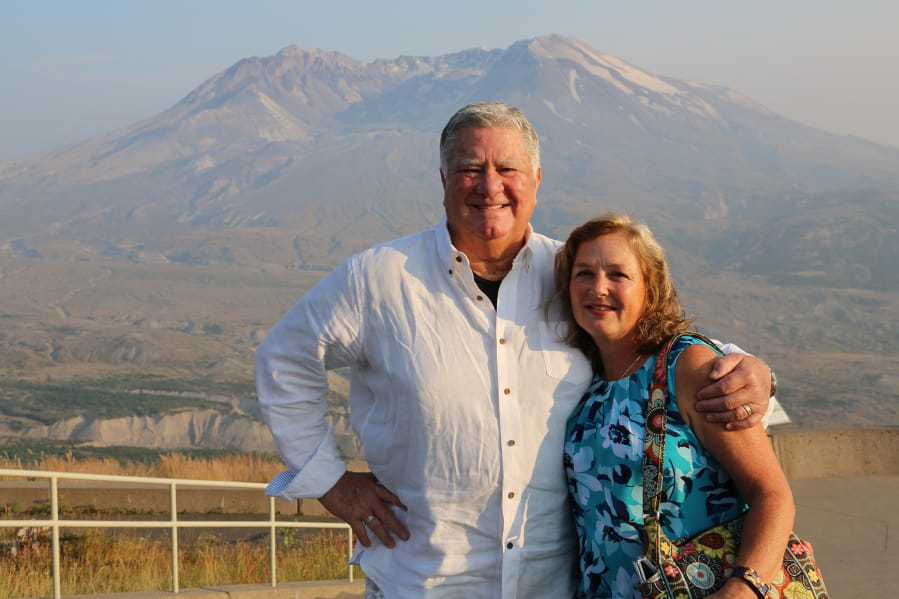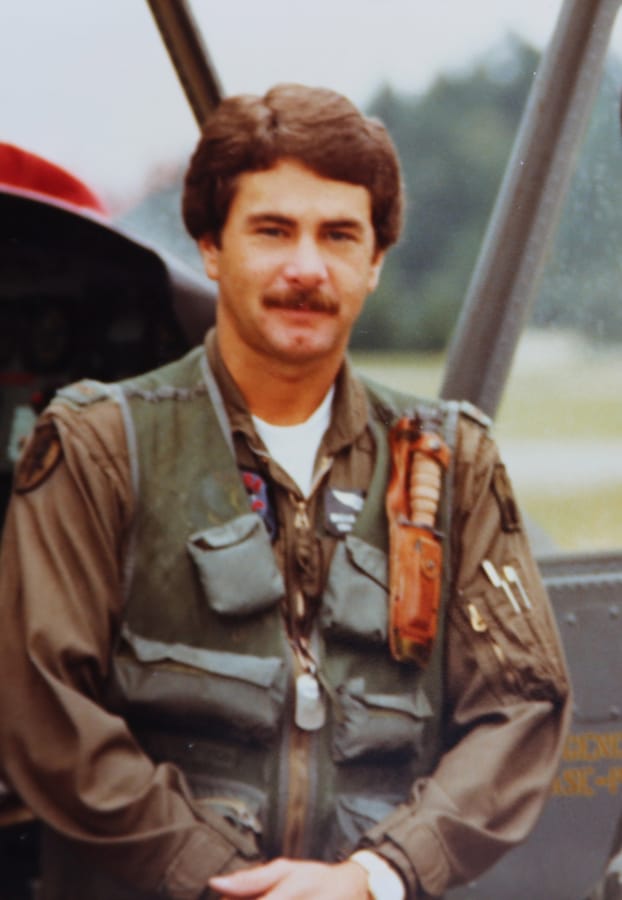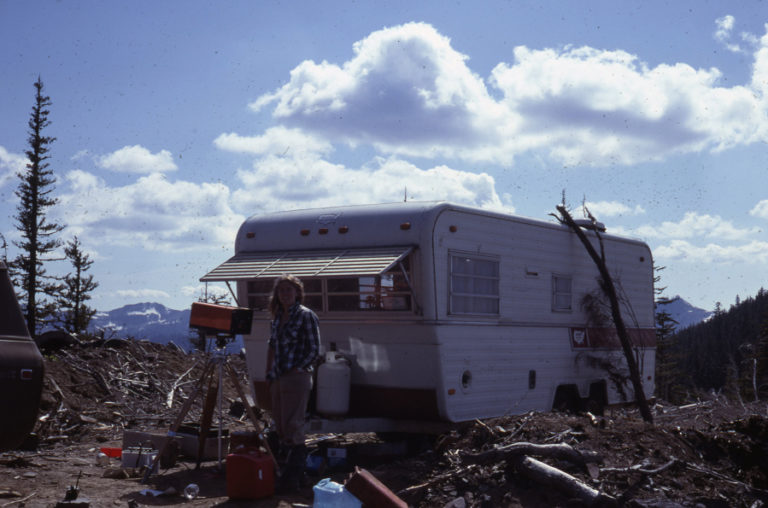Help from above saved campers
“Don’t waste a miracle.”
That’s what Sue Nystrom tells herself when she considers her narrow escape that Sunday morning on Mount St. Helens.
Nystrom and her boyfriend were trudging through a wasteland of volcanic ash and toppled trees, trying to find help for four friends. Suddenly, helped dropped from the sky. It was a National Guard helicopter piloted by Mike Cairns.
They were airlifted to Kelso, along with another survivor. Nystrom (she was Sue Ruff back then) has wanted to thank the pilot, which she did when they were reunited this summer at the volcano.
'We'll Meet Again'
(All episodes scheduled for 8-9 p.m. on KOPB-TV, Channel 10)
• Jan. 23: “Children of World War II”
• Jan. 30: “Rescued from Mount St. Helens”
• Feb. 6: “Lost Children of Vietnam”
• Feb. 13: “Heroes of 9/11”
• Feb. 20: “Freedom Summer”
• Feb. 27: “Coming Out”
Information: www.pbs.org/show/meet-again
While Mindy Brugman never had a chance to thank David Johnston for saving her life, she was able to share her feelings with his sister.
Those emotional meetings are woven into six episodes of a television series — “We’ll Meet Again” — that begins this month on PBS. It follows the lives of people whose paths intersect during dramatic chapters of history. It is hosted by Emmy-winning journalist Ann Curry, who also is executive producer.
The second episode — “Rescued from Mount St. Helens” — is built around the 1980 volcanic eruption. It will air at 8 p.m. Jan. 30 on Oregon Public Broadcasting.
Nystrom and boyfriend Bruce Nelson were among a group of six friends camping north of Mount St. Helens, outside the restricted zone. Dan Balch and Brian Thomas were seriously injured by the blast. Nystrom and Nelson couldn’t find Karen Varner and Terry Crall among the all downed trees.
“We called and called and called,” Nystrom, 58, said. (They learned later that Varner and Crall died when a tree fell on their tent.)
So Nystrom and Nelson headed out on a tortuous trek to find help.
“Our intention was to get to a bigger road or a point of reference where our chances of being seen would go up,” she said by phone from Mexico, where she spends the winter.
Their help came by way of a National Guard training exercise near Yakima. Helicopter pilot Mike Cairns said that his unit was in a morning briefing when the eruption began at 8:32 a.m.
“Phones started to ring off the hook. Somebody from the state said get out of there, we’ll need you to do any type of rescue work or assistance we could do.
“We looked to the west and could see the entire western sky blacker than I’d ever seen it, and it went for miles up into the air. There was lightning, and the leading edge was just ugly. We made a spot decision to take off as ash was falling on our aircraft. Five or six made it out that day.
“We were given quadrants to search, even though we couldn’t see more than 200 yards. It was covered with ash, trees were down; it looked like a moonscape. There was no visibility above us,” said Cairns, who had received a Purple Heart as a gunship pilot during the Vietnam War.
His crew chief spotted tracks that Nystrom and Nelson had left in the ash, and Cairns eventually was able to land the helicopter.
“We had to commit to the landing; we would lose sight of the ground 50 feet above ground because of the amount of ash,” he said. “We didn’t see the ground until we were two or three feet above it.”
As Nystrom and Nelson were being flown to Kelso, along with a third survivor, the couple had something else in mind. Balch and Thomas, who had a broken hip, had to be rescued too.
“They didn’t want to go back unless we got them,” Cairns said by phone from the Seattle area.
Jesse Hagerman, piloting a smaller helicopter, “made a phenomenal landing on a one-lane bridge” to rescue Thomas.
Another team rescued Balch.
“We got back to Kelso about 5 p.m. The fuel light was blinking. We had five to 10 minutes of fuel left,” Cairns said. “It was not a wise decision, but we didn’t have a choice.”
When Nystrom and Cairns were reunited last year at the viewpoint now known as Johnston Ridge Observatory, she had a surprise for the 70-year-old Army and National Guard veteran.
His bravery inspired Nystrom to join the National Guard, she said. She served for 34 years, including a deployment in Afghanistan.
“Not only did he save my life,” Nystrom said, “he inadvertently pushed me into a career.”
Scientist saved others, but didn’t survive
“I really did my utmost to kill myself.”
That’s how Mindy Brugman recalls May 17, 1980.
The glacier researcher was among a trio of young scientists who were planning to camp overnight at an observation point near Mount St. Helens.
Brugman is alive because of David Johnston.
“He said, ‘You wouldn’t be safe here, and I do think you should go,’ ” Brugman said.
So Brugman, Carolyn Driedger and Harry Glicken drove back to Vancouver that Saturday night.
Johnston stayed and was among 53 people who died a few hours later in the eruption.
Brugman was studying glaciers on Mount St. Helens as part of her post-graduate work at Caltech. When the volcano started getting active, her adviser thought it was too dangerous, she said. “I had to promise I wouldn’t hurt myself.”
Brugman also made the case that she could contribute to valuable research. She had better instrumentation than the U.S. Geological Survey scientists, she said.
“I was able to confirm that the mountain was moving a meter a day to the north. Their data meter was older and took a number of days to get the result,” Brugman said by phone from Vancouver, B.C.
“In all reality, I didn’t think the mountain would get me,” said Brugman, now a senior researcher with the Meteorological Service of Canada.
Brugman and Driedger, now a hydrologist at the Cascades Volcano Observatory in Vancouver, and geologist Harry Glicken had planned to camp on the mountain Saturday night. (Glicken died in 1991 in a volcanic eruption in Japan.)
They were at the Coldwater II observation point, where Johnston was based as he monitored the volcano.
“We had our tent and sleeping bags out of the car,” Driedger said.
“We didn’t want to drive to Vancouver and come back” the following morning, Brugman said. However, Johnston explained in detail why they should not be there.
It was an analysis the volcanologist had also shared with former Columbian reporter Tom Ryll, who was filmed for the TV episode. Ryll gave Brugman some information about Johnston’s family in Illinois.
Ryll recalled the warning Johnston issued to reporters during a March 1980 press briefing.
“I have a very distinct memory of that day in a parking lot at Spirit Lake. David Johnston said that it was a very dangerous place to be,” Ryll said. At one point, his footing got a little jiggly.
“David Johnston said, ‘Do you realize that what rolled through is an earthquake?’ ”
Brugman and Driedger were driving back to their Coldwater II observation point that Sunday morning. They didn’t get far.
“The mountain started erupting when we were in Woodland,” Brugman said. “I called David, and there was no answer; that’s not unusual with a radio.”
She then called the USGS office and was told to return to Vancouver. Brugman and Driedger spent the next couple of days handing out press releases.
“Eventually, things quieted down and I could measure the glacier,” Brugman said. “I did some papers on it.”
Brugman, now 62, said that the passing of 37 years hasn’t erased one aspect of that fateful weekend.
“Carolyn and I are the last two people still alive to have spoken to David,” she said. “I was very disappointed for his loved ones. If I was in their shoes, I would be devastated to lose a brother.”
That’s why Brugman was glad that the TV project brought her together with Pat Ruthenberg, Johnston’s sister and only surviving member of his immediate family.
Ruthenberg wanted to know what Johnston’s last evening was like, Brugman said.
“And Pat wanted to know whether he was happy.”






